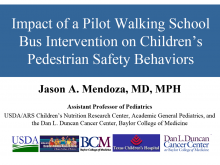We are pleased to announce an exciting new alliance between Active Living Research and GP RED to co-host and coordinate...
Impact of a Pilot Walking School Bus Intervention on Children's Pedestrian Safety Behaviors

Presentation at the 2011 Active Living Research Annual Conference
Background:
Walking School Buses (WSB) are groups of children, led to and from school by parents or other adults, in which children are picked up at designated “bus stops.” Pedestrian safety should be taught and modeled by the adults on the walk to school. WSB programs have been reported to increase children’s active commuting to school and physical activity; however, the impact on children’s pedestrian safety behaviors has not been well studied.
Objectives:
To conduct a pilot evaluation of a WSB program’s impact on children’s pedestrian safety behaviors.
Methods:
We conducted a group randomized controlled trial among 4th grade students in eight low socioeconomic status, elementary schools in Houston, TX. The 149 enrolled 4th graders were ethnically diverse. The intervention was a WSB program led by study staff available 5-days/week. Schools were matched by race/ethnicity and % qualifying for free/reduced lunch, then randomized to intervention or control conditions. Outcomes were measured prior to the intervention (Time 1) and during week 5 of the intervention (Time 2). We measured children’s pedestrian safety behaviors with a previously validated instrument. Children were observed for the following five behaviors considered important to pedestrian safety: crossed at a corner or crosswalk, crossed with an adult or safety patrol, stopped at the curb, looked left-right-left, and walked (not ran) across the street. Children were classified as walking with a WSB program based on wearing the distinctive WSB reflective safety vests provided each day to the WSB students. We conducted observations before school without interacting or deliberately influencing the children’s or adults’ behaviors. No individual sociodemographic information was collected and the data reflect the behaviors of child pedestrians of any grade level approaching a major intersection at the study schools (n=1252 at Time 1 and n=1296 at Time 2). To determine differences for the global pedestrian safety behavior score (scale of 0-5), we used a linear mixed-model regression analysis with school as a random and time as independent effects. To determine differences for each of the individual pedestrian safety behaviors, we used generalized mixed model analyses with school as a random and time as independent effects. A planned sub-analysis at Time 2 compared WSB students versus non-WSB students at the intervention school.
Results:
The linear mixed-model regression yielded no significant main effects for the WSB intervention on the school-wide global pedestrian safety behavior score. The generalized mixed model analyses yielded significant group by time effects for the WSB intervention on three of the individual pedestrian safety behaviors: (1) crossing at a corner or crosswalk, children at the intervention school increased by 16.4% while children at the control school increased by 4.1% (p<0.001); (2) crossing with an adult or safety patrol, children at the intervention school decreased by 0.5% while children at the control school decreased by 9.9% (p<0.001); and (3) stopping at the curb, children at the intervention school decreased by 4.6% while children at the control school increased by 19.5% (p<0.001), although the proportion exhibiting the behavior at Time 2 was similar between groups. Among students at the intervention school at Time 2, students who were part of a WSB had higher global pedestrian safety behavior scores than non-WSB students (4.6 +/-0.6 vs. 3.2 +/- 0.9, p<0.0001).
Conclusions:
A pilot WSB program intervention targeted at 4th grade students had no effect school-wide to improve a composite indicator of children’s pedestrian safety behaviors, although a sub-analysis suggested that the WSB was associated with higher scores among WSB-participating students at the intervention school at Time 2. Tertiary analyses revealed preliminary evidence of influence on certain individual indicators school-wide, although caution needs to be exerted on the possibility of enhanced Type I errors. Further work is necessary to improve specific pedestrian safety behaviors through the WSB program and provide a more targeted, well-powered evaluation.
Support:
RWJF Active Living Research (63773), NCI (1R21CA133418 and 1K07CA131178), and USDA Cooperative Agreement (6250-51000-047)
Related Tools & Resources
STAY UP TO DATE
RECENTLY ADDED TOOLS & RESOURCES
MOVE! A BLOG ABOUT ACTIVE LIVING
The "Active Living Conference" aims to break down research and practice silos and...







